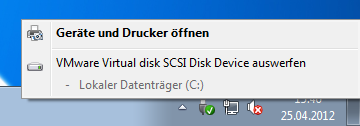Will We Use Cloud-Based Virtual Desktops in 2020?
A desktop delivered from the cloud, accessible from everywhere, providing just the right amount of computing power for the task at hand, maintained by the cloud provider and paid for only when used – a dream? Or a commodity in ten years’ time? Time will tell, but in the meantime let us find out if such a virtual wonder device is even possible.
What is a Cloud-Based Desktop?
While many are speculating not if, but when the web will replace operating system “dinosaurs” such as Microsoft Windows I prefer to focus on what users need to get stuff done: a single place to run all their applications from and access all their data. Voilà, we just defined the term “desktop”.
Traditional desktops are implemented by installing some kind of fat, old legacy OS on a chunk of hardware sitting on or below the user’s desk. Although that model has its merits, it lacks maintainability and coolness, to name a few. Enter the cloud.
Cloud desktops are not hosted on a specific piece of hardware. Instead they run in the “cloud”, similar to electrons flowing freely above atoms in metals. The abstraction from the physical hardware not only has the potential to increase availability, but also enables dynamic sizing, where available processing power is adjusted to the current workload. That is both elegant and power-efficient.
If cloud desktops only had the benefits outlined above, they would be quite boring. Not for a technician, but for a manager. What is the point of virtualizing a desktop if it is as complex and costly to run afterwards as before? Consider an example:
You decide it is time you blogged in order to promote your name/products/ideas or whatever. Very probably you have a lot to say about your topic, but it is highly unlikely that you are knowledgeable in the field of maintaining a public blog system on the internet. That means installing WordPress on a server of your own is a very bad idea. But paying a provider to host a virtual machine with WordPress in it is only marginally better – it is still you who has to maintain the system, install updates, replace outdated plugins and so on. Face it: those are tasks you suck at because they are not your core business. And in addition to operating a bad blogging platform you neglect making money because all the WordPress maintainance jazz keeps you from doing what you are good at.
To make cloud desktops appeal economically, administration needs to be moved to people whose core business it is to maintain desktops. Only they will build fully automated procedures for administering thousands of desktops at once, cutting maintenance costs dramatically along the way.
Going back to our blog example, instead of hosting your own WordPress instance have someone host it for you, provide WordPress as Software as a service (SaaS). WordPress.com seems to be pretty good at that, providing basic blog services for free while charging reasonably low amounts for more advanced features like custom stylesheets or your own domain name.
Summing it up, a cloud-based desktop is built upon two abstractions:
- The software is abstracted from the hardware (using virtualization technology).
- The service a software provides is abstracted from a specific installation (using delegated administration).
The cloud desktop concept is remarkably similar to outsourcing in the management world, and just as outsourcing it has severe drawbacks.
Who Would Use a Cloud-Based Desktop?
I see two customer groups with very different needs and expectations: end users and corporations. For the latter, a cloud-based desktop promises reduced costs and improved business agility. But can providers deliver what companies need? Flexibility? If cloud desktops are to be successful, they need to be easier to introduce than, say, SAP R/3 where the company structure is morphed to fit the software’s needs instead of the other way round. But providers will have a hard time providing flexibility at low cost. They can only maintain the low price tag combined with high quality if everything is standardized, from the applications they make available to the management procedures. Flexibility is what suffers along the way.
Could end users be tempted to forgo the flexbility of their PCs in exchange for all the shiny benefits of the cloud? Given the recent success of the iPad it seems possible. After all, very few really are capable of maintaining their copy of Windows/Linux/OS X, and those that are should be spending their time more productively. Please do not misunderstand me: Microsoft has done a great job of making Windows more accessible to a large crowd, but computers in general (not only Windows machines) are still way too difficult to use to become truly ubiquitous. That is, by the way, the reason why user experience is becoming increasingly important as Apple is able to show its competitors time and again.
Assuming end users are willing to give up their PCs for a snappy and shiny cloud-based desktop – could they even do it?
What is Needed to Make Cloud-Based Desktops a Reality?
A PC is different from an iPad-like device in that it is used to store and manipulate large amounts of data, most notably pictures and videos. Today, users store their data at home, on their PCs. If cloud desktops are to become reality, that data needs to move to the cloud, too. But we are not talking about a one-time relocation, difficult but somehow doable. No, every time somebody shoots a new video clip of their newborn with their 3D HD video camera, the resulting video file needs to be uploaded to the cloud. Fast. That calls for way more bandwith than we have today in many more places than we have today – and not only in the upstream like today!
Corporations might be able to procure that bandwidth, but how to implement the flexibility they need? One answer to that question could be layering. If cloud desktop providers focused on building rock-solid base systems with the most commonly used stuff inside, enterprises could layer their line of business applications on top (if they are not web-based anyway).
Remains the question of where (corporate) data would be stored. I can imagine “cloud data providers” replacing today’s file servers just like banks some day replaced mattresses for safekeeping money.
How realistic are cloud-based virtual desktops in 2020? Or is that even too late? Brian Madden optimistically puts the industry on a much tighter schedule and expects something vaguely similar by 2015. I am not sure the current cloud hype will last for the next 10 years. Maybe we will turn back to the 80ies soon, start wearing bad clothes and think that decentralization is a great idea.







